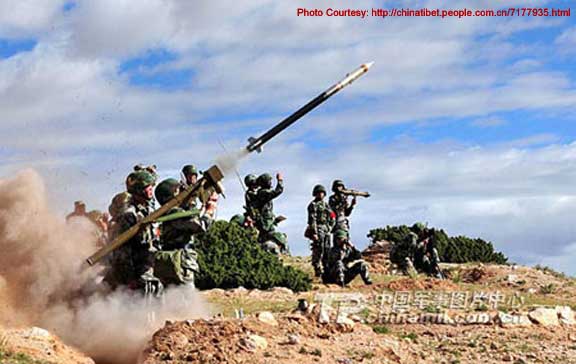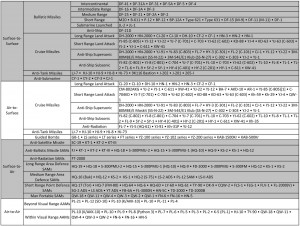China’s Defence Modernisation
China has shifted gears since the collapse of its major threat, namely the Soviet Union, in the early nineties of the last century. Their paramount leader, Deng Xiaoping had ordained that ‘small and medium local conflicts and not general wars were the most likely threats.’ Gradually the Chinese have, especially after the Gulf War, honed their doctrine to “ Local Wars under Conditions of Informationisation.” China’s military modernization strategy is based on the “PLA’s simultaneous transformation” through mechanization and informationisation. The Chinese have been rapidly building up their Information Warfare capabilities. There are reportedly 30000 computer professionals and two hacker brigades in the Chinese forces.
The Chinese Air Force is currently undergoing a feverish qualitative upgrade. Its vintage fleet is being rapidly replaced by third and fourth generation fighters…
- Strategic Forces : China maintains nuclear deterrence employing land based ICBMs. China has currently around 250 nuclear warheads in its inventory with the arsenal growing. It has around 60 ICBMs ( DF-31 of 8000kms and DF-31A of 13000 kms range). By 2020, experts opine that it will have 100 ICBMs and 6 Jin class nuclear submarines each armed with 12 sea launched ballistic missiles. Besides DF-25 medium range ballistic missiles, China’s Second Artillery Corps has over 1000 short range ballistic missiles with conventional warheads.
- Land Forces: The PLA is the world’s largest army with 1.6 million men. As per the Military Balance, it has 40 divisions to India’s 28 with 7660 main battle tanks to India’s 3900 and nearly 18000 artillery pieces to India’s a little over 10000. Besides there are nearly 60 divisions worth of the People’s Armed Police as an internal security force, the bulk of which are demobilizedPLAdivisions.
- The PLA Navy: For expanding naval ambitions not only in the seas surrounding it, but for naval operations against Taiwan and in the entire Asia-Pacific to thwart even the US flotilla and the navies of the other countries in its vicinity, the Chinese Navy is the focus of modernization. By 2020-25, it could have three aircraft carrier battle groups, 60 submarines including 10 nuclear and nearly 80 surface combatants. The Indian Navy may just have two/three carriers and 16-18 submarines with 2 nuclear submarines and 58 surface combatants.
- PLAAF : The Chinese Air Force is currently undergoing a feverish qualitative upgrade. Its vintage fleet is being rapidly replaced by third and fourth generation fighters like the Russian Su-27 and Su-30 and its Chinese copy, the J-11. The mainstay is the J-10 which is reportedly a F-16 equivalent fighter. It is also jointly developing the JF-17 multi-role aircraft with Pakistan and is programmed to receive 250 of these. Like India, it already has air-to-air refueling and the AWACS capability. By 2020, it will have over 2300 fourth/fifth generation combat aircraft compared to India’s 750 aircraft in the best possible modernisation scenario for India——— thus this asymmetry remains operationally unacceptable. Importantly, it is planning to build 60 airfields in Tibet alone.
- China tested its first anti-satellite missile in early 2007 and in 2010 conducted an anti-ballistic missile test. It has launched three manned missions and a lunar orbiter. It is planning for nano satellites that will serve as space mines and by 2020 plans to have 200 remote sensing satellites and a military space station—- the first in the world !
- Rapid Reaction Forces: China is developing rapid reaction capability for catering to speedy and potent responses to varying battlefield contingencies. These high-technology based rapid reaction forces will cater for small scale intense local military operations or in support of pre-emptive operations. The Chinese already have a fully operational Airborne Corps and another Airborne Corps HQ is under raising. These forces could be tasked also in support of China’s “core interests” as specified above, in case required.
China’s Water Hegemony
Tibet is the water reservoir of India. China virtually exercises control over the waters of rivers like the Tsangpo ( Brahmaputra), Indus and Sutlej flowing into India owing to is superior upper riparian position in the Tibet plateau. Substantiated reports convey the alarming fact that China plans to unilaterally divert the waters of the Brahmaputra to its vast arid areas in the north and west. It also has commenced work to dam some other rivers flowing into India. India’s hydel project on the Brahmaputra, upstream of Pasighat,has been hanging fire for a very long time. Chinese callous attitude in its areas in water management upstream of the Indian rivers has resulted in two devastating flash floods for India. In June 2000 parts of Arunachal Pradesh were suddenly flooded due to the bursting of Yiong River Dam or release of water from the dam. In 2005 again, the Sutlej river was flooded in Himachal Pradesh from the Pare Chu Lake in Tibet causing havoc to many low lying villages in some regions of Himachal Pradesh in the vicinity of the Indo-China border. In addition, its proposed construction of the 116 metres high Zangmu Dam on the Tsangpo in eastern Tibet in a high seismic zone can cause havoc to Assam in the event of a major earthquake in the region.
India needs to take the lead to energise all Asian groupings like the ASEAN to ensure peace and stability in the Asia-Pacific region with active cooperation of the US and Australia.
Though Prime Minister Dr Manmohan Singh himself assuaged the concerns of Indian parliamentrians in the Rajya Sabha in August 2011 regarding China’s diversion of waters from the Brahmaputra or damming it inside China, India will be well advised to ensure its satellite intelligence coverage of China’s activities in this field are zealously monitored. China has a propensity to keep its water strategies under wraps and does not allow any outsiders for on- site visits. It has disregarded UN recommendations on water and information sharing on earlier occasions.
A Wake-Up Call for India
Notwithstanding the frequent and dozens of rounds of dialogue between India and China since the last few years to discuss many vexed issues between the two countries including the contentious border issue, Chinese actions towards India are hardly encouraging. China appears to be still suffering from the “ Middle Kingdom” syndrome and resents Indian aspirations as the second Asian power. Its ‘string of pearls’ stratagem aims at the strategic encirclement of India to confining India to the backwaters of the Indian Ocean and to restrict India merely to South Asia.
China’s nuclear weapons- cum- missiles nexus with its client state, Pakistan, and modernizing the Pakistani Armed Forces is singularly aimed against India. For China, Pakistan is a low-cost guarantor of security against India and China now a high value guarantor of security for Pakistan against India. Since the last two years or so, the Chinese footprint in the disputed POK region is growing under the garb of engineer personnel being stationed in the region ( approximately 7000 to 10000 personnel already there) and reports suggest that POK may be leased to China for 50 years or so. China and Pakistan appear to have decided to convert POK as Pakistani territory and in doing so, legitimize the 5180 sq kms of POK ceded by Pakistan to China in 1963 as Chinese sovereign territory. With these ominous developments, India thus faces another front to secure against Pak-China collusion.
China has successfully made serious inroads into India’s immediate neighbourhood through Nepal, Bangladesh, Mynamar and Sri Lanka providing them subsidized arms and military training facilities besides constructing strategic infrastructure for them.
…the Indian government must not play down Chinese challenges in any form.
China’s further mischief in issuing stapled visas to Indian citizens from J&K visiting China and laying territorial claims to Arunachal Pradesh, calling it Southern Tibet, all point towards China’s evil machinations towards India. Despite India’s continuing friendly overtures towards China, at times bordering on the submissive, it appears that China will, most likely, adopt a confrontationist policy towards India. Competition for foreign markets and global influence are likely to spur multiple challenges between the two rising Asian giants and thus India needs to factor in the myriad Chinese stratagems in the long term perspective.
Prognosis and the Indian Response
The not so “peaceful rise” of China and its provocative actions vis-à-vis India—– some as already stated in this article— portends more competition than cooperation between the two Asian giants. China’s own stated reunification policies points to the fact that it can use military power to regain certain parts in its neighbourhood which it perceives to be its own. Thus, India as it endeavours to resolve all contentious problems with China in a mature and peaceful manner, must get gear up to face the Chinese dragon squarely for China only respects strength. In order to do that we need to is, firstly, correctly assess likely Chinese threats both in the short-term and long term perspectives. In particular, the Indian government must not play down Chinese challenges in any form. Secondly, we must address with determination, the military asymmetry to counter the threat from China and ensure no bureaucratic sluggishness or procedural shortcomings in the identification of and procurement of our military hardware for all the three services in a speedy time-frame. The three services must be made capable for offensive operations in Chinese territory. Thirdly, we must pay adequate attention to further develop our strategic infrastructure leading to the Indo-China border. Nuclear and space assets require to be vastly improved as well as our electronic and cyber warfare wherewithal. Fourthly, under an international umbrella we need to go for either bilateral or regional water-management treaties between India and China and the other Asian lower riparian states. Fifthly, India needs to take the lead to energise all Asian groupings like the ASEAN to ensure peace and stability in the Asia-Pacific region with active cooperation of the US and Australia.
It is high time that India carried out a reality check of its overall capabilities vis-à-vis China. It now needs to upgrade its military strategy from dissuasion to deterrence. For effective deterrence, India needs to enhance the capabilities of its nuclear forces by fielding 5000 km range Agni IV and V Intermediate Range Ballistic Missiles and sea launched long range missiles by nuclear subs to complete the nuclear TRIAD for our forces. The synergy of the three services and India’s future military build-up to deter the formidable Chinese will only be suitably energised if the country goes in for long awaited defence reforms in India’s higher defence management structure.






